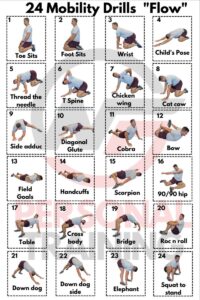Introduction:
Imagine a body that moves with grace, agility, and ease—a body that feels alive, capable, and empowered. This is the promise of mobility exercises, a gateway to unlocking the full potential of our physical selves. In a world where the sedentary lifestyle has become the norm, prioritizing mobility is not just about fitness; it’s a fundamental aspect of reclaiming our natural state of movement.
This article delves deep into the realm of mobility exercises, exploring their profound impact on our muscles, joints, and overall well-being. From simple stretches to complex mobility drills, we’ll uncover the science behind these movements and their ability to enhance flexibility, prevent injuries, and improve functional performance. Join us on this transformative journey as we rediscover the joy and freedom of a body in motion.
Unlock Your Full Range of Motion: A Guide to Mobility Exercises
Have you ever felt restricted in your movements, whether during workouts or daily activities? Lack of mobility can hinder performance and lead to discomfort. Fortunately, incorporating a variety of mobility exercises into your routine can help improve flexibility, range of motion, and overall functionality. In this article, we’ll explore a range of effective mobility exercises that target different areas of the body, helping you move and feel better.
Arm Circles:
Start with small circles and gradually increase the size to warm up the shoulder joints. Reverse the direction after a few repetitions.
Cat Cow Pose:
Move between arching your back (cow pose) and rounding it (cat pose) to stretch and mobilize the spine.
Thoracic Spine Rotation:
Sit or stand tall and gently twist your upper body from side to side, focusing on the thoracic spine’s mobility.
Deep Squat:
Lower into a deep squat position to improve hip and ankle mobility while also stretching the lower back and thighs.
Hip Circles:
Rotate your hips in circular motions to enhance hip joint mobility and reduce stiffness.
Shoulder CAR (Controlled Articular Rotation):
Perform controlled rotations with your shoulders in different planes to increase shoulder mobility and stability.
Stretching:
Incorporate various stretching exercises targeting major muscle groups to improve flexibility and range of motion.
Ankle Circles:
Rotate your ankles in circles to improve ankle mobility, crucial for proper squatting and walking mechanics.
Butterfly Stretch:
Sit with the soles of your feet together and gently press your knees toward the floor to stretch the groin and hips.
Frog Squat:
Assume a wide squat position with your hands on the floor, gently pushing your knees outward to stretch the inner thighs.
Lunges:
Alternate between forward lunges, reverse lunges, and lateral lunges to improve hip flexibility and leg strength.
Squats:
Perform bodyweight squats or use a resistance band to deepen the stretch and strengthen the lower body.
Chest and Shoulder Opener:
Interlace your fingers behind your back and lift your arms to stretch the chest and shoulders.
Hip Flexor Stretch:
Kneel on one knee and lean forward to stretch the hip flexors of the back leg.
Banded Hip Mobilization:
Wrap a resistance band around your thighs and perform side steps or squats to improve hip mobility.
Crossover Arm Stretch:
Extend one arm across your chest and gently pull it with the opposite hand to stretch the shoulders and upper back.
Hitchhiker:
Lift your arms overhead and then bend at the elbows, bringing your hands behind your head like a “hitchhiker” to stretch the shoulders.
Leg Swings:
Stand tall and swing one leg forward and backward to loosen up the hips and improve dynamic flexibility.
Lying Hip Rotation:
Lie on your back and gently rotate your hips from side to side to increase hip mobility.
Rolling Your Back:
Sit on the floor and roll your spine down, segment by segment, then roll back up to stretch and mobilize the spine.
Samson Lunge:
Step one foot forward into a lunge position, reach the opposite arm overhead, and lean slightly to the side to stretch the hip flexors and side body.


Incorporating these mobility exercises into your daily routine can lead to significant improvements in your overall movement quality, flexibility, and joint health. Remember to perform each exercise mindfully, focusing on proper form and breathing. Consistency is key to reaping the full benefits of mobility training. Start today and unlock your body’s full potential.
As we conclude this exploration of human body mobility, it’s evident that movement is not just a physical act but a profound expression of our vitality and potential. By embracing mobility exercises as a fundamental part of our daily lives, we can unlock a multitude of benefits—from improved flexibility and strength to enhanced mental clarity and overall well-being. Let’s continue to prioritize movement, honoring the intricate connection between body and mind, and embracing the joy of a body that moves with freedom, grace, and resilience